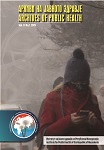Evaluation of the influence of alcoholism as a social-medical factor on the occurrence of brain hemorrhages
Published 2019-04-06
Keywords
- alcoholism,
- brain hemorrhages,
- hypertension,
- atherosclerosis,
- risk factors
- public health aspect ...More
How to Cite
Abstract
Purpose of the paper: To determine the effect of alcohol consumption on the emergence and treatment of hypertensive brain hemorrhages and the harmful effects on morbidity and mortality of patients. Material and methods: A retrospective study of 61 patients was performed at the University Clinic of Neurosurgery from 2011 to 2016 with various manifestations of brain bleeding. Patients were divided into 2 groups: with and without emphasized risk factors. In the group with emphasized risk factors 15 examinees consumed alcohol. The following variables were examined: sex, age, bleeding volume, compression, the outcome of treatment and functional mobility. Results: The results indicate that alcoholism significantly affects the onset of brain bleeding, especially in patients who consume more than 200 ml of alcohol per day. The most likely cause is liver damage and hemostasis disorder. Conclusion: Alcoholism as a socio-medical factor has a significant role in the occurrence of brain hemorrhages.
Downloads
References
- Casolla B, Dequatre – Ponchelle N, Rossi C, Henon H, Leys D. Heavy alcohol intake and intracerebral hemorrhage. Neurology 2012; 79(11):1109-1115
- Институт за јавно здравје. Информација за состојбата со болестите на зависност во Република Македонија, 2015-2016, Скопје.
- Weisberg LA. Alcoholic intracerebral hemorrhage. Stroke 1988; 19(12): 1565-1569.
- Панговски Иван. Фреквенција и значење на социо-медицинските ризик фактори во превенција на спонтаните хипертензивни мозочни крварења. Магистерски труд, 2016. Медицински факултет – Скопје.
- Gebel JM, Jauch EC, Brott TG, Jane K, Sauerbeck L, Salisbury S, et al. Relative edema volume is a predictor of outcome in patients with hyperacute intracerebral hemorrhage. Stroke 2002; 33 (11): 2636-2641
- Ching – Jen C, Brown W M, MoomawC J, Langefeld C, Osborne J, Worrall B B, et al. Alcohol use and risk of intracerebral hemorrhage. Neurology 2017; 88(21):2043-2051.
- Juvela S. Alcohol abuse and hemorrhagic stroke. In book: Alcohol and heart disease, Publisher: Taylor & Francis, London, Editors: Watson RR, Myers AK, pp. 58-71. University of Helsinki, Helsinki, Finland
- Панговски И, Шумковски Р, Гавриловска A, Рендевски В, Панговски Ив. Важноста, Aктуелноста и значењето на лекувањето на спонтаните интрацербрални хематоми. Зборник на трудови. Неврохируршки симпозиум за интрацеребрални крварења, Скопје 2010
- Indira Y, Muralidhar MV, Munisekhar K. Role of smoking and alcoholism in cerebrovascular accidents. International Journal of Physiotherapy and research 2014; 2(3):530-536
- Gever J, Senior Editor, Med Page Today, 25 June, 2009. Heavy daily drinking boosts chances of lethal brain hemorrhage. Available at https://www.medpagetoday.org/criticalcare/strokes/14868
- Herzig R, Urbanek K., Vlachova I., Schneiderka P, Mares J. The Role of Chronic alcohol intake in patients with spontaneous intracranial hemorrhage: A Carbohydrate – Deficient Transferin Study. Cerebrovasc Dis 2003; 15:22-28.
- Klatsky A L, Armstrong M A, Friedman G D, Sidney S. Alcohol drinking and risk of hemorrhagic stroke. Neuroepidemiology 2002; 21:115-122.
- Costa P, Grassi M, Iacoviello L, Zedde M. Alcohol intake and the risk of intracerebral hemorrhage in the elderly, The MUCH – Italy. Neurology 2018; 91(3):e227-e235.

